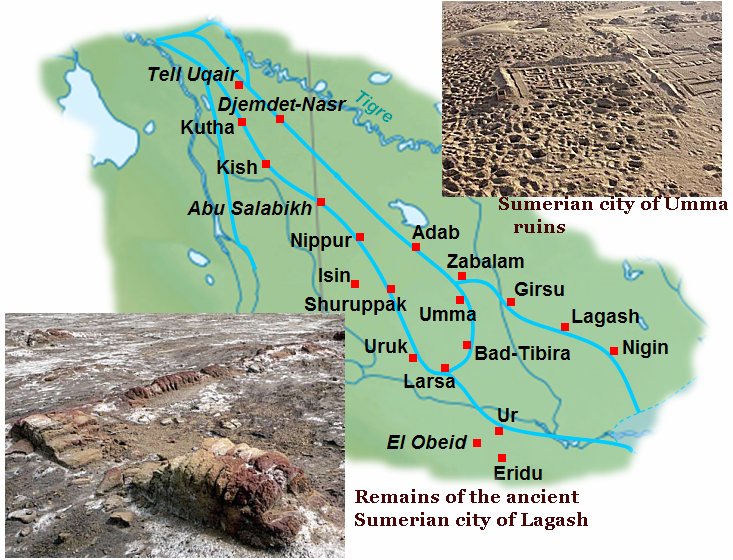Infamous End Of Lugalzagesi – Ambitious King Who United Sumer
A. Sutherland - AncientPages.com - Lugalzagesi was a Sumerian king who reigned c. 2341 BC - 2316 BC and lived in the mid-fourteenth century BC.
According to his inscriptions, he came to power as the 'ensi' of the Umma city that reached its zenith c. 2275 BC. A royal inscription states that his father, Bubu, was the previous 'ensi' of Umma.
In the Sumerian King List, he is mentioned as the king of the Third Dynasty of Uruk with a reign of 25 years; however, chronology regarding his rule is somewhat uncertain.
He was also the high priest of Nisaba, the Sumerian goddess of writing, learning, harvest, and the patroness of scribes; she was worshiped in sanctuaries and shrines at Umma. Lugalzagesi, who united all Sumer city-states and conquered many foreign countries, called himself "King of all nations."
His reign lasted 25-34 years, depending on which version of the Sumerian king list is correct.
Undoubtedly, it was an outstanding achievement to unite the Sumerian city-states, and it was not an easy task. These city-states had a tradition of independence and were frequently at war.
Most attempts to unite Sumer had failed until Lugalzagesi, a strong ruler, an ambitious and military-minded 'ensi' from neighboring Umma, appeared on the scene, and he could unite the cities of Sumer. In the long-lasting conflict between Umma and Lagash, Lugalzagesi inflicted a severe defeat on the rival town and managed to win supremacy over the whole country as king of Uruk.
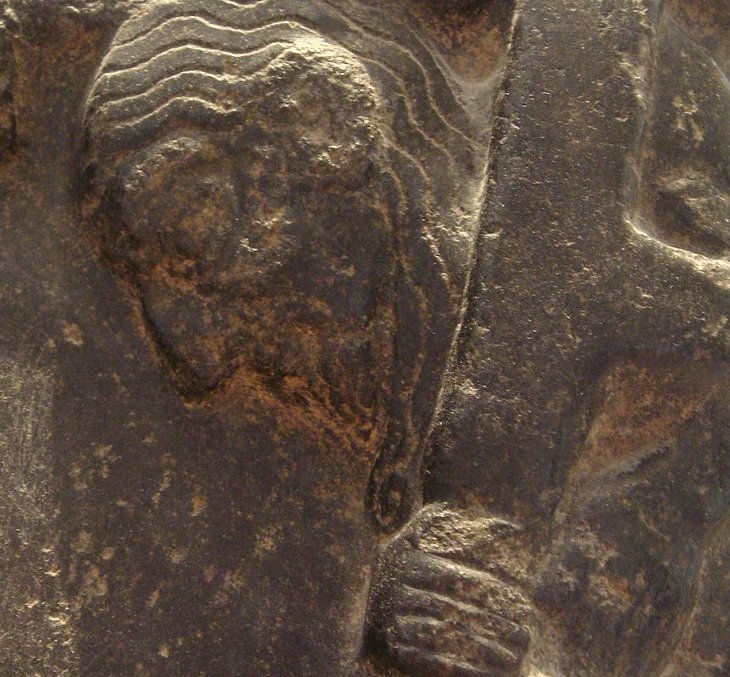 Governor of Umma, King of Uruk, King of the Land. Prisoner in a cage, probably king Lugalzagesi of Uruk due to his oversize figure, being hit on the head with a mace by Sargon of Akkad. Akkadian Empire victory stele circa 2300 BCE. Louvre Museum. Image credit: ALFGRN - CC BY-SA 2.0
Governor of Umma, King of Uruk, King of the Land. Prisoner in a cage, probably king Lugalzagesi of Uruk due to his oversize figure, being hit on the head with a mace by Sargon of Akkad. Akkadian Empire victory stele circa 2300 BCE. Louvre Museum. Image credit: ALFGRN - CC BY-SA 2.0
The union of Sumerians by Lugalzagesi had a very high price. He attacked and besieged neighboring Girsu, the second major city of the kingdom of Lagash, and his war with Urukagina, King of Lagash, was extremely cruel.
The destruction of Lagash city was Lugalzagesi's revenge for the long-lasting humiliation of Umma, though his initial attacks against Lagash were unsuccessful. He was involved in the 150-year-long conflict with Lagash for a fertile plain of Gu-Edin ('Guedena'), a fertile plain mentioned in the Stele of the Vultures, the oldest known historical document. This stele has a long inscription in the Sumerian language that confirms the recurring conflict between the neighboring city-states of Lagash and Umma. It also informs about the victory of Eannatum, king of Lagash.
His reliefs covering the two faces of the stele inform that he burned, looted, and destroyed practically all the holy places of Lagash.
These vicious deeds of Lugalzagesi are recorded in a remarkable document written by a Lagashite scribe and theologian, no doubt at the behest of Urukagina, who – there is reason to believe – survived the catastrophe.
An ancient source (a lamentation) says that Lugalzagesi launched a devastating attack and destroyed Lagash:
"The ruler of Umma has set fire to the temple of Antasura; he has carried away the silver and the lapis lazuli… He has shed blood in the temple of the goddess Nanshe; he has carried away the precious metal and precious stones.
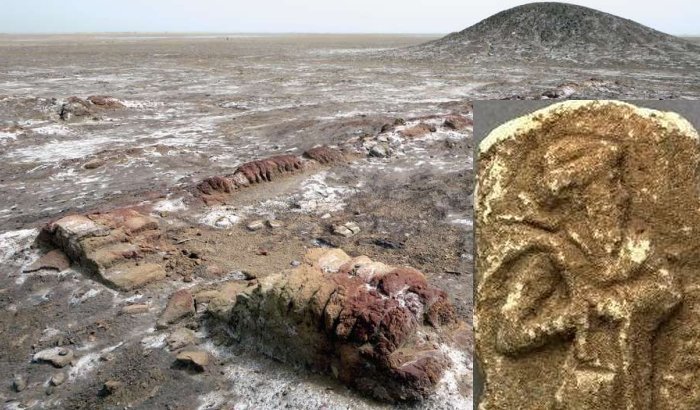 Left: "Mudbrick foundations and a ziggurat are among the remains of the 3rd millennium BC Sumerian city-state of Lagash (Tell al Hiba) northeast of Nasiriyah, Iraq." source; Right: Urukagina, an illegitimate and controversial claimant to power, the last king of the first dynasty of Lagash who came to power divinely - as he claimed - when Ningirsu, warrior of Enlil, granted him the kingship of Lagash.
Left: "Mudbrick foundations and a ziggurat are among the remains of the 3rd millennium BC Sumerian city-state of Lagash (Tell al Hiba) northeast of Nasiriyah, Iraq." source; Right: Urukagina, an illegitimate and controversial claimant to power, the last king of the first dynasty of Lagash who came to power divinely - as he claimed - when Ningirsu, warrior of Enlil, granted him the kingship of Lagash.
The Man of Umma has committed a sin against the god Ningirsu… May, the hand that he dared to raise against Ningirsu be cut off. There was no fault in Urukagina, King of Lagash. May Nisaba, the goddess of Lugalzagesi, ruler of Umma, make him bear his mortal sin upon his neck." 1
These prophetic words were finally fulfilled, but it took time before they happened.
In the meantime, in addition to Lagash, Lugalzagesi also overcame Kish, Ur, Nippur, Larsa, and Uruk; therefore, he called himself "King of all nations."
The devastation of cities and the looting of temples were always condemned and never forgotten by history. Among the rules of war in prehistory was the one saying that the longer the city resisted, the worse fate it met when it was finally captured. If the inhabitants gave up quickly, they could count on the forgiveness of the conqueror, but if the siege lasted a long time because of the citizens' resistance, such a city was doomed. It happened to Girsu and Lagash.
With Sumer secured, Lugalzagesi focused on the Semitic-speaking lands to the north along the Tigris and Euphrates rivers. However, shortly after his Euphrates and Tigris campaigns, Lugalzagesi had little time to secure his power across these vast regions he had just conquered.
"After some two decades of military successes and triumphs, he was brought in a neck stock to the gate of Nippur to be reviled and spat upon by all who passed by.
His conqueror was a Semite named Sargon," the founder of a five-generation Akkadian dynasty that created a capital city at Akkad.
Updated on June 21, 2022
Written by – A. Sutherland - AncientPages.com Senior Staff Writer
Copyright © AncientPages.com All rights reserved. This material may not be published, broadcast, rewritten or redistributed in whole or part without the express written permission of AncientPages.com
Expand for referencesReferences:
- Kriwaczek, Paul. Babylon: Mesopotamia and the Birth of Civilization
- N. Kramer, The Sumerians
Arjomand Saïd Amir, Revolution: Structure and Meaning in World History
More From Ancient Pages
-
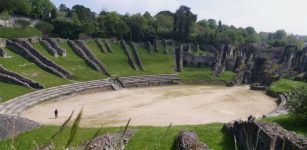 Huge Gallo-Roman Amphitheater Of Saintes Will Be Saved For Future Generations – New Project Started
News | Jan 23, 2021
Huge Gallo-Roman Amphitheater Of Saintes Will Be Saved For Future Generations – New Project Started
News | Jan 23, 2021 -
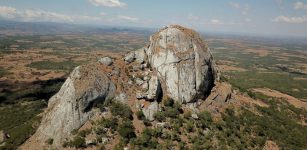 Ancient DNA Reveals Surprises About Life Of Early Africans
Archaeology | Feb 24, 2022
Ancient DNA Reveals Surprises About Life Of Early Africans
Archaeology | Feb 24, 2022 -
 Baba Yaga: Enigmatic, Powerful Archetypal Witch In Slavic Folklore
Slavic Mythology | May 16, 2016
Baba Yaga: Enigmatic, Powerful Archetypal Witch In Slavic Folklore
Slavic Mythology | May 16, 2016 -
 Riddle How Human’s Uniquely DNA Evolved Solved By Scientists
DNA | Jan 13, 2023
Riddle How Human’s Uniquely DNA Evolved Solved By Scientists
DNA | Jan 13, 2023 -
 Luna Settlement: First Multi-Year European Settlement Identified In Pensacola, Florida
Archaeology | Dec 26, 2015
Luna Settlement: First Multi-Year European Settlement Identified In Pensacola, Florida
Archaeology | Dec 26, 2015 -
 Rare, Well-Preserved Medieval Bone Flute Found In Kent
Archaeology | Nov 24, 2022
Rare, Well-Preserved Medieval Bone Flute Found In Kent
Archaeology | Nov 24, 2022 -
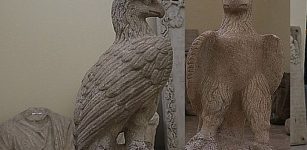 Two 2,000-Year-Old Marble Eagle Statues Found In Anatolian Hellenistic Temple
Archaeology | Aug 12, 2019
Two 2,000-Year-Old Marble Eagle Statues Found In Anatolian Hellenistic Temple
Archaeology | Aug 12, 2019 -
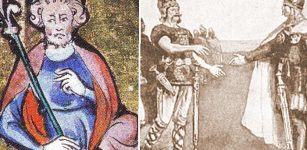 Battle Of Assandun: The Great Battle In English History And A Brief Period Of Viking Dominion In England
Featured Stories | Apr 11, 2016
Battle Of Assandun: The Great Battle In English History And A Brief Period Of Viking Dominion In England
Featured Stories | Apr 11, 2016 -
 Ilopango Volcanic Eruption In Maya World 1590 Years Ago – New Study
Archaeology | Oct 2, 2020
Ilopango Volcanic Eruption In Maya World 1590 Years Ago – New Study
Archaeology | Oct 2, 2020 -
 Ancient DNA Reveals A Diverse Community Lived At Machu Picchu, The ‘Lost City Of The Incas’
Archaeology | Jul 26, 2023
Ancient DNA Reveals A Diverse Community Lived At Machu Picchu, The ‘Lost City Of The Incas’
Archaeology | Jul 26, 2023 -
 On This Day In History: Ferdinand Magellan Reached Pacific And South American Strait – On Nov 28, 1520
News | Nov 28, 2016
On This Day In History: Ferdinand Magellan Reached Pacific And South American Strait – On Nov 28, 1520
News | Nov 28, 2016 -
 Who Was The Sapa Inca?
Ancient History Facts | Jan 27, 2016
Who Was The Sapa Inca?
Ancient History Facts | Jan 27, 2016 -
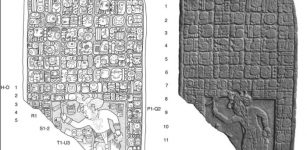 Long-Lost Ancient Maya Kingdom Unearthed In Mexico
Archaeology | Mar 12, 2020
Long-Lost Ancient Maya Kingdom Unearthed In Mexico
Archaeology | Mar 12, 2020 -
 Evidence Of The Moon-Eyed People – More Clues – Part 2
Civilizations | Dec 29, 2019
Evidence Of The Moon-Eyed People – More Clues – Part 2
Civilizations | Dec 29, 2019 -
 Underground Hellenistic Necropolis With Tombs With Frescoes, Reliefs Unearthed In Naples, Italy
Archaeology | May 13, 2023
Underground Hellenistic Necropolis With Tombs With Frescoes, Reliefs Unearthed In Naples, Italy
Archaeology | May 13, 2023 -
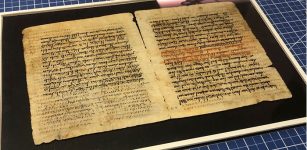 Lost Ancient Texts Of The Star Catalogue Composed By The Greek Astronomer Hipparchus Found
News | Feb 21, 2023
Lost Ancient Texts Of The Star Catalogue Composed By The Greek Astronomer Hipparchus Found
News | Feb 21, 2023 -
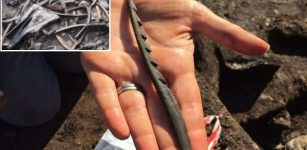 Archaeologists Shed Light On The Lives Of Stone Age Hunter-Gatherers In Britain
Archaeology | Jan 20, 2023
Archaeologists Shed Light On The Lives Of Stone Age Hunter-Gatherers In Britain
Archaeology | Jan 20, 2023 -
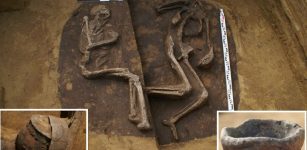 Unusual Grave Of The Trzciniec Culture Is An Archaeological Puzzle
Archaeology | Dec 23, 2019
Unusual Grave Of The Trzciniec Culture Is An Archaeological Puzzle
Archaeology | Dec 23, 2019 -
 Jigai – Suicide Ritual For Wives Of Samurai – Feminine Counterpart Of Seppuku
Ancient History Facts | Feb 24, 2018
Jigai – Suicide Ritual For Wives Of Samurai – Feminine Counterpart Of Seppuku
Ancient History Facts | Feb 24, 2018 -
 DNA Study Sheds Light On The Mysterious Picts Of Scotland
DNA | Jul 7, 2023
DNA Study Sheds Light On The Mysterious Picts Of Scotland
DNA | Jul 7, 2023

